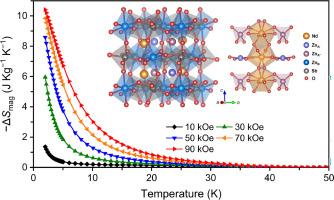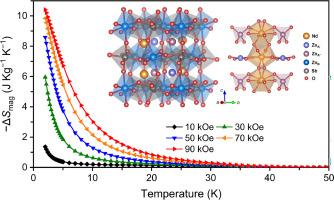a位柱状和b位岩盐型锌基钙钛矿Nd2ZnZn(Zn2Sb2)O12的低温磁热学性质
IF 9.3
1区 材料科学
Q1 MATERIALS SCIENCE, MULTIDISCIPLINARY
引用次数: 0
摘要
钙钛矿结构材料的性能对阳离子(和阴离子)有序度高度敏感。因此,了解控制这些订单的策略是很重要的。本文报道了高压高温合成zn基Nd2ZnZn(Zn2Sb2)O12钙钛矿的第一个例子,在a位上以柱状形式存在满阶Nd3+和Zn2+(方形平面和四面体位置有Zn2+),在八面体B位上以岩盐形式存在满阶Zn2+和Sb5+。样品是在6 GPa的中等压力下制备的,这比文献中提出的钙钛矿的压力范围(14-18 GPa)要小得多。样品在1.8 K以下表现出顺磁性。另一方面,它表现出很强的比热磁场依赖性,表明在低温下存在显著的磁热效应,并通过比热和等温磁化测量进一步量化。考虑到这种化合物的结构特征,它可能是在一维晶格中探索稀土磁性的一个原型。本文章由计算机程序翻译,如有差异,请以英文原文为准。


Cryogenic magnetocaloric properties of zinc-based perovskite Nd2ZnZn(Zn2Sb2)O12 with A-site columnar-type and B-site rock-salt-type orders
Properties of perovskite-structure materials are highly sensitive to the degree of cation (and anion) orders. Therefore, it is important to know strategies of controlling such orders. Here we report a high-pressure, high-temperature synthesis of the first example of a Zn-based Nd2ZnZn(Zn2Sb2)O12 perovskite, with a full order of Nd3+ and Zn2+ at A sites in the columnar-type manner (with Zn2+ at square-planar and tetrahedral sites) and with a full order of Zn2+ and Sb5+ at octahedral B sites in the rock-salt-type manner. The sample was prepared at a moderate pressure of 6 GPa, which is much smaller than the pressure range (14–18 GPa) proposed in the literature for such perovskites. The sample exhibited paramagnetic behavior down to 1.8 K. On the other hand, it showed strong magnetic-field dependence of specific heat, indicating a notable magnetocaloric effect at low temperatures, which was further quantified using both specific heat and isothermal magnetization measurements. Considering the structural features, this compound could be an archetype for exploring rare-earth magnetism in a one-dimensional lattice.
求助全文
通过发布文献求助,成功后即可免费获取论文全文。
去求助
来源期刊

Acta Materialia
工程技术-材料科学:综合
CiteScore
16.10
自引率
8.50%
发文量
801
审稿时长
53 days
期刊介绍:
Acta Materialia serves as a platform for publishing full-length, original papers and commissioned overviews that contribute to a profound understanding of the correlation between the processing, structure, and properties of inorganic materials. The journal seeks papers with high impact potential or those that significantly propel the field forward. The scope includes the atomic and molecular arrangements, chemical and electronic structures, and microstructure of materials, focusing on their mechanical or functional behavior across all length scales, including nanostructures.
 求助内容:
求助内容: 应助结果提醒方式:
应助结果提醒方式:


